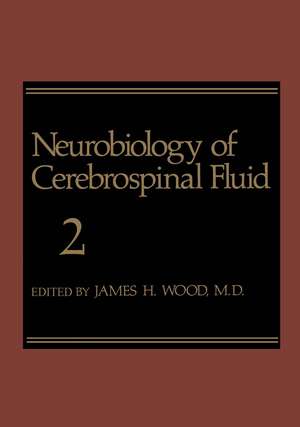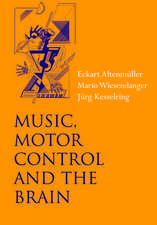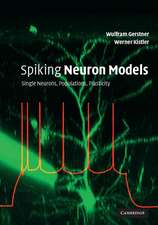Neurobiology of Cerebrospinal Fluid 2
Editat de James H. Wooden Limba Engleză Paperback – 13 mar 2012
Preț: 989.50 lei
Preț vechi: 1206.70 lei
-18% Nou
Puncte Express: 1484
Preț estimativ în valută:
189.33€ • 197.70$ • 156.35£
189.33€ • 197.70$ • 156.35£
Carte tipărită la comandă
Livrare economică 15-29 aprilie
Preluare comenzi: 021 569.72.76
Specificații
ISBN-13: 9781461592716
ISBN-10: 1461592712
Pagini: 1008
Ilustrații: XLII, 962 p.
Dimensiuni: 178 x 254 x 58 mm
Greutate: 1.71 kg
Ediția:Softcover reprint of the original 1st ed. 1983
Editura: Springer Us
Colecția Springer
Locul publicării:New York, NY, United States
ISBN-10: 1461592712
Pagini: 1008
Ilustrații: XLII, 962 p.
Dimensiuni: 178 x 254 x 58 mm
Greutate: 1.71 kg
Ediția:Softcover reprint of the original 1st ed. 1983
Editura: Springer Us
Colecția Springer
Locul publicării:New York, NY, United States
Public țintă
ResearchDescriere
Since the publication of Neurobiology of Cerebrospinal Fluid 1 in 1980, that text has become the definitive reference concerning cerebrospinal fluid (CSF) for both basic scientists and clinicians involved in the investigation of degenerative, convulsive, cerebrovascular, traumatic, immunological, demyelinating, inflammatory, neoplastic, neuroendocrine, and psychiatric disorders. That initial volume began a tradition of detailed topic reviews written by international authorities with first-hand expertise in their respective fields of CSF research. Neurobiology of Cerebrospinal Fluid 2 represents a hefty collection of extensively refer enced and illustrated chapters covering topics not discussed in Vol. 1. More specifically, these chapters contain ample charts of original data, summary charts, and anatomical diagrams. Detailed illustrations of experimental and clinical techniques have been in cluded to facilitate their practical application. Each chapter in this multidisciplinary text has been critically reviewed by two experts in the respective field, and the appropriate revisions have been made. Recently published references and text modifications have been added at the proof stage in an effort to provide the most up-to-date review chapters possible.
Cuprins
1: Cerebrospinal Fluid as Reflection of Internal Milieu of Brain.- 1. Introduction.- 2. Anatomy of CSF System.- 3. Composition of CSF.- 4. Sites of CSF Formation.- 5. Formation of CSF.- 6. Circulation of CSF.- 7. Absorption of CSF.- 8. Functions of CSF.- References.- 2: Regulation of Acid-Base Equilibrium of Cerebrospinal Fluid.- 1. Introduction.- 2. Acid-Base Equilibrium of CSF.- 3. Factors That Control CSF Pco2.- 4. Factors That Affect CSF Bicarbonate Concentration.- 5. Conclusion.- References.- 3: Physiology and Pharmacology of Peptide, Steroid, and Other Hormones in Cerebrospinal Fluid.- 1. Introduction to Central Hormonal Integration.- 2. Neuroendocrine Function of CSF.- 3. Endogenous and Exogenous Hormones and Neuropeptides in CSF.- 4. Conclusions.- References.- 4: Substance P in Human Cerebrospinal Fluid.- 1. Introduction.- 2. Methods.- 3. Characteristics of Substance-P-like Immunoreactivity in Human Lumbar CSF.- 4. Origin of Substance-P-like Immunoreactivity in Lumbar CSF.- 5. Lumbar CSF Substance-P-like Immunoreactivity in Neurological Disorders.- 6. Drug Effects on CSF Concentration of Substance-P-like Immunoreactivity.- 7. Conclusions.- References.- 5: Choroid-Plexus Transport of Enkephalins and Other Neuropeptides.- 1. Introduction.- 2. Materials and Methods.- 3. Methionine-Enkephalin Uptake.- 4. D-Alanine-5-L-Methionine Enkephalinamide Uptake.- 5. Prolactin and Luteinizing-Hormone-Releasing-Hormone Uptake.- 6. Conclusions.- References.- 6: Fraction I Endorphin in Cerebrospinal Fluid: Clinical Studies.- 1. Biochemical Characteristics of Assay System.- 2. Possible Relevance in Chronic Pain States and Depressive Disorders.- 3. Possible Relevance in Schizophrenia.- 4. Conclusion.- References.- 7: Analgesia Induced by Brain Stimulation in Man: Its Effect on Release of ?-Endorphin and Adrenocorticotropin into Cerebrospinal Fluid.- 1. Analgesia by Stimulation of Periaqueductal Gray.- 2. Analgesia by Intraventricular Administration of ?-Endorphin.- 3. Periaqueductal-Gray-Stimulation-Induced Elevation of ?-Endorphin and ACTH in Ventricular CSF.- 4. L-Tryptophan Therapy.- 5. Mechanisms of ?-Endorphin Release.- 6. Conclusions.- References.- 8: Cerebrospinal Fluid as Neuroregulatory Pathway: Peptides in Neuropsychiatric Illness.- 1. Introduction.- 2. Anatomy and Physiology of CSF Pathway: An Active Behavioral Regulatory Link?.- 3. Peptide Synthesis and Catabolism: Markers in CSF.- 4. Peptides in CSF in Relation to Neuropsychiatric Illness.- 5. Conclusions.- References.- 9: Neurochemistry of Cerebrospinal Fluid in Normal Individuals: Relationship between Biological and Psychological Variables.- 1. Introduction.- 2. Methods.- 3. Normal Values.- 4. Sources of Variance.- 5. Correlations among Biological Measures.- 6. Investigation in Normal Individuals of Hypothesized Neurotransmitter-Behavioral Correlations.- 7. Comments.- References.- 10: Neurochemical Analysis of Rat Cisternal Cerebrospinal Fluid.- 1. Introduction.- 2. Neurochemical Methods.- 3. Neuropharmacological Studies.- 4. Discussion.- 5. Conclusion.- References.- 11: Cerebrospinal Fluid Monoamine Metabolites in Korsakoff’s Disease: Relationship to Memory Impairment and Drug Response.- 1. Introduction.- 2. CSF Monoamine Metabolites in Korsakoff’s Disease.- 3. Drug Response in Korsakoff’s Disease.- 4. Summary.- References.- 12: Endogenous Hallucinogens in Cerebrospinal Fluid: Measurement and Meaning.- 1. Introduction.- 2. General Comments on Dimethyltryptamine and O-Methylbufotenin Analysis by Selected Ion Monitoring.- 3. Methods.- 4. Clinical Studies and Discussion.- 5. Summary.- References.- 13: Dopamine-?-Hydroxylase in Cerebrospinal Fluid: Putative Indicator of Central Noradrenergic Activity.- 1. Introduction.- 2. Basic Pharmacological Studies.- 3. Clinical Studies.- 4. Suggestions for Future Research.- References.- 14: Cerebrospinal Fluid Acetylcholinesterase in Neuropsychiatric Disorders.- 1. Introduction.- 2. Psychiatric Syndromes.- 3. Neurological Syndromes.- 4. Summary.- References.- 15: Cerebrospinal Fluid Enzymes in Neurological Disease.- 1. Introduction.- 2. CSF Enzymes in Health and Disease.- 3. Enzymes in CSF during Development.- 4. Clinical Value of Determination of Enzyme Activities in CSF.- 5. Conclusion.- References.- 16: Passage of Proteins from Blood to Cerebrospinal Fluid: Model for Transfer by Pores and Vesicles.- 1. Introduction.- 2. CSF Dynamics.- 3. CSF Protein.- 4. Blood-Brain Barrier Morphology and Protein Penetration.- 5. Mechanisms for Protein Entry into CSF.- 6. Summary.- References.- 17: Nonimmunological Glycoproteins in Cerebrospinal Fluid.- 1. Introduction.- 2. Glycoproteins, Glycosaminoglycans, and Gangliosides in CSF.- 3. Glycosidases and Glycosyltransferases in CSF.- 4. Origin of Glycoproteins in CSF..- 5. CSF Glycoproteins in Relation to Neural Function.- 6. Determination of Glycoprotein-Carbohydrate in CSF.- 7. Glycoprotein-Carbohydrate in Neurological Diseases.- 8. Glycoprotein-Carbohydrate in Schizophrenia and Depression.- 9. Conclusions.- References.- 18: Cellular and Humoral Immune Responses in Human Cerebrospinal Fluid.- 1. Introduction.- 2. Research Strategies for Analysis of Immunocompetent Cells in CSF: Joint Space in Rheumatoid Arthritis as Model of Immunological Responses in Closed Compartment.- 3. Immunocompetent Cells in Central Nervous System and CSF: Correlation between Parenchymal and CSF Cellular Infiltrates in Experimental Models.- 4. Immunocompetent Cells in Central Nervous System and CSF: Correlation between Parenchymal and CSF Cellular Infiltrates in Humans.- 5. Immunocompetent Cells in Human CSF.- 6. Soluble Products of Immunocompetent Cells in Human CSF.- 7. Conclusion.- References.- 19: Central Nervous System Immunoglobulin Synthesis in Neurological Disease: Quantitation, Specificity, and Regulation.- 1. Introduction.- 2. Evidence, Detection, and Quantitation of Immunoglobulin Synthesis within Central Nervous System.- 3. Cytological Substrate for intra-BBB Immunoglobulin Synthesis— Plasma Cells.- 4. In Vitro Synthesis of Immunoglobulin by CSF Cells.- 5. Lymphatic Channels in Central Nervous System.- 6. Cellular Immune Regulation and Immunoglobulin Synthesis in Demyelinating Diseases.- 7. Modulation of Immunoglobulin Synthesis.- 8. Hypothesis.- 9. Conclusion.- References.- 20: Cerebrospinal Fluid Proteins in Infectious Neurological Diseases and Guillain-Barré Syndrome.- 1. Introduction.- 2. Infectious Neurological Diseases and Guillain-Barré Syndrome.- 3. CSF Immunoglobulin Abnormalities of Restricted Heterogeneity in Other Neurological Diseases.- 4. Conclusion.- References.- 21: Pathogenesis of Bacterial Meningitis: Relationship to Opsonic Activity in Normal Cerebrospinal Fluid.- 1. Introduction.- 2. Pathogenesis of Bacterial Meningitis.- 3. Opsonization and Phagocytosis.- 4. Normal CSF.- 5. Opsonic Activity of CSF.- 6. Summary.- References.- 22: Depressed Cell-Mediated Immunity in Cerebrospinal Fluid of Patients with Malignant Glioma.- 1. Introduction.- 2. Materials and Methods.- 3. Results.- 4. Discussion.- 5. Summary.- References.- 23: Malignant Cells in Cerebrospinal Fluid and Their Clinical Significance.- 1. Introduction.- 2. Techniques in CSF Cytology.- 3. Normal and Abnormal Cells in CSF.- 4. Meningeal Metastasis: Signs, Symptoms, and Treatment.- 5. Review of Literature.- 6. False-Positive CSF Cytology.- 7. Summary and Conclusions.- References.- Suggested Reading.- 24: Computed Tomography of Cerebrospinal Fluid Dissemination of Malignant Neoplasms.- 1. Introduction.- 2. Clinical Protocol.- 3. Pathology.- 4. Computed Tomographic Manifestations of Meningeal Neoplasms.- 5. Conclusions.- References.- 25: Clinical Correlations of Cerebrospinal Fluid Polyamine Levels.- 1. Introduction.- 2. CSF Polyamines in Central Nervous System Tumors.- 3. Clinical Utility of CSF Polyamine Determinations.- 4. CSF Polyamines in Pituitary Disease.- 5. CSF Polyamines in Subarachnoid Hemorrhage.- 6. Other Factors That May Influence CSF Polyamine Levels.- 7. Future Directions.- References.- 26: Enhancement of Delivery of Antineoplastic Drugs into Cerebrospinal Fluid.- 1. Introduction.- 2. Factors Involved in Drug Delivery into CSF.- 3. Enhancement of CSF Drug Delivery Using Alternative Anatomical Approaches.- 4. Enhancement of CSF Drug Delivery by Administration of High-Dose Systemic Chemotherapy.- 5. Enhancement of CSF Drug Delivery by Alteration of CSF Drug- Disappearance Kinetics.- 6. Enhancement of CSF Drug Delivery by Alteration of Blood-Brain Barrier.- 7. Enhancement of CSF Drug Delivery by Modifying Drug Structure.- 8. Summary.- References.- 27: Cerebrospinal Fluid Markers of Central Nervous System Radiation and Chemotherapy Damage.- 1. Introduction.- 2. Central Nervous System Radiation Toxicity.- 3. Central Nervous System Chemotherapy Toxicity.- 4. CSF Markers of Central Nervous System Damage.- 5. Studies of Myelin Basic Protein.- 6. Summary.- References.- 28: Cerebrospinal Fluid Alterations in Spinal-Cord Injury.- 1. Introduction.- 2. Clinical Studies: Human Spinal-Cord Injury.- 3. Laboratory Studies: Experimental Spinal-Cord Injury.- 4. Conclusion.- References.- 29: Perinatal Intraventricular Hemorrhage Jonathan Hellman and Robert C. Vannucci.- 1. Introduction.- 2. Pathogenesis of Intraventricular Hemorrhage.- 3. Neuropathology.- 4. Radiographic Abnormalities.- 5. Clinical Manifestations.- 6. Alterations in CSF.- 7. Pathogenesis of Hypoglycorrhachia.- 8. Summary.- References.- 30: Evaluation of Subarachnoid and Intraventricular Hemorrhage by Computed Tomography.- 1. Subarachnoid Hemorrhage.- 2. Intraventricular Hemorrhage.- 3. Summary.- References.- 31: Subarachnoid Hemorrhage Secondary to Central Nervous System Neoplasia.- 1. Introduction.- 2. Diagnosis and Etiology of Subarachnoid Hemorrhage.- 3. Hemorrhage from Cerebral Tumors.- 4. Pathogenesis of Tumoral Hemorrhage.- 5. Summary.- References.- 32: Cerebrospinal Fluid Cytology after Subarachnoid Hemorrhage.- 1. Introduction.- 2. Cell-Collecting Device and CSF-Cell-Smearing Method.- 3. Preparation of CSF Cells for Electron Microscopy.- 4. Appearance of Normal CSF Cells.- 5. CSF after Subarachnoid Hemorrhage.- 6. Discussion.- 7. Summary.- References.- 33: Xanthochromic Compounds in Cerebrospinal Fluid: Quantitative Spectrophotometry and Electromigration.- 1. Introduction.- 2. Technique of Quantitative CSF Spectrophotometry.- 3. Diagnostic Significance.- 4. Conclusions.- References.- 34: Pharmacological Vasoconstrictor Activity of Cerebrospinal Fluid: Relationship to Arterial Caliber and Clinical Vasospasm after Subarachnoid Hemorrhage and Aneurysm Surgery.- 1. Introduction.- 2. Cerebral Arterial Spasm and Subarachnoid Hemorrhage.- 3. Preliminary Analysis of CSF.- 4. Longitudinal CSF Analysis with Clinicoradiological Correlations.- 5. Summary.- References.- 35: Prostaglandins in Cerebrospinal Fluid: Possible Role in Cerebrovascular and Neurological Disease.- 1. Brief Review of Biosynthesis and Clinical Importance of Prostaglandins.- 2. Possible Role of Prostaglandins in Cerebrovascular and Neurological Disease.- 3. Production and Efflux of Prostaglandins from Brain.- 4. Biological Problems of Detection.- 5. Techniques for Quantitation of Prostaglandins in CSF.- 6. Prostaglandin Levels in Human CSF.- 7. Implications for Therapy.- 8. Conclusions.- References.- 36: Metabolic Fate of Adenosine in Cerebrospinal Fluid.- 1. Introduction.- 2. Metabolism of Adenosine, Inosine, and Hypoxanthine in CSF.- 3. Determination of Loss of U-[14C]Purines from CSF into Blood.- 4. Mechanism of Incorporation of Adenosine and Inosine from CSF into Brain Nucleotides.- 5. Relative Incorporation of Adenosine, Inosine, and Hypoxanthine from CSF into Brain Nucleotides.- 6. Conclusions.- References.- 37: Cerebrospinal Fluid Alterations in Pregnancy and Eclampsia.- 1. Introduction.- 2. Pregnancy-Induced Hypertension.- 3. CSF Characteristics.- 4. Summary.- References.- 38: Pharmacology of Anticonvulsant Drugs in Cerebrospinal Fluid.- 1. Introduction.- 2. Methods for Studying CSF Entry and Exit of Anticonvulsants.- 3. Distribution of Anticonvulsant Drugs between CSF and Plasma.- 4. Anticonvulsant Drug Distribution in CSF in Convulsive States.- 5. Conclusions.- References.- 39: Body Position and Cerebrospinal Fluid Pressure.- 1. Basic Concepts.- 2. Mechanical Effects of Postural Changes.- 3. Regulatory Effects of Postural Changes.- 4. Clinical Implications.- References.- 40: Cerebrospinal Fluid Pulse Pressure as Parameter of Intracranial Elastance.- 1. Introduction.- 2. Analytical Method.- 3. Clinical Observations.- 4. Experimental Studies.- 5. Conclusions.- 6. Definitions of Abbreviations and Mathematical Symbols.- References.- 41: Autonomic Nervous Control of Cerebrospinal Fluid Production and Intracranial Pressure.- 1. Introduction.- 2. Nerve Fibers in Choroid Plexus.- 3. Sympathetic Influence on Choroid-Plexus Function.- 4. Cholinergic Influence on CSF Formation.- 5. Sympathetic Denervation and Intracranial Pressure.- 6. Summary.- References.- 42: Adrenergic-Receptor Mechanisms in Mammalian Choroid Plexus.- 1. Introduction.- 2. General Background to Role of Cyclic AMP in Mediating Hormone- Receptor Function.- 3. Studies with Broken-Cell Preparations of Whole Choroid Plexus.- 4. Localization of Choroid-Plexus ?-Adrenergic Receptors.- 5. Conclusions.- References.- 43: Alteration in Choroid-Plexus Blood Flow and Cerebrospinal-Fluid Formation by Increased Ventricular Pressure.- 1. Introduction.- 2. Choroid-Plexus Blood Flow.- 3. Alteration of Choroid-Plexus Blood Flow and Secretion.- 4. Summary.- References.- 44: Intracranial Hypertension in Experimental Animals and Man: Quantitative Approach to System Dynamics of Circulatory Cerebrospinal Fluid.- 1. Introduction.- 2. Formulation of CSF System Model.- 3. Model Application: Simulated Subarachnoid Hemorrhage in Dog.- 4. Model Application: Confirmation of Pressure-Sensitive Formation Model in Rat.- 5. Model Application: Pseudotumor Cerebri in Man.- 6. Summary.- References.- 45: Mechanisms of Cerebrospinal Fluid Absorption in Normal and Pathologically Altered Arachnoid Villi.- 1. Introduction.- 2. Arachnoid Villi: Structural Considerations.- 3. Arachnoid Villi: Functional Aspects of Villus Structure.- 4. Arachnoid Villi: Pathological Alterations.- 5. Summary.- References.- 46: Bacterial Meningitis: Selected Aspects of Cerebrospinal Fluid Pathophysiology.- 1. Introduction.- 2. Complications and Neurological Sequelae of Bacterial Meningitis.- 3. Proliferation and Clearance of CSF Bacteria in Experimental Meningitis.- 4. CSF Outflow Resistance in Experimental Bacterial Meningitis.- References.- 47: Cerebrospinal Fluid Circulatory Dynamics in Pseudotumor Cerebri and Response to Steroid Therapy.- 1. Introduction.- 2. Clinical Features.- 3. Pathogenesis.- 4. Intracranial-Pressure Monitoring and Manometric Flow Studies.- 5. Prognosis and Therapy.- 6. Summary.- References.- 48: Differential Effects of Pentobarbital, Ketamine Hydrochloride, Enflurane, and Halothane on Cerebrospinal Fluid Dynamics.- 1. Introduction.- 2. Cardiovascular Function, Cerebrovascular Reactivity, and Cerebral Metabolism.- 3. Anesthetic Agents and CSF Formation.- 4. Effects of Anesthetic Agents on CSF Absorption.- 5. Summary.- References.- 49: Effect of Mannitol-Induced Hyperosmolarity on Transport between Brain Interstitial Fluid and Cerebrospinal Fluid.- 1. Introduction.- 2. Brain Interstitial Fluid.- 3. Hyperosmolar Solutions.- 4. Summary.- References.- 50: Clearance of Edema Fluid into Cerebrospinal Fluid: Mechanism for Resolution of Vasogenic Brain Edema.- 1. Introduction.- 2. Movement of Edema Fluid through Brain Tissue.- 3. Resolution of Vasogenic Brain Edema by Movement into Ventricular CSF.- 4. Quantitative Measurement of Amount of Edema Clearance into Ventricular CSF.- 5. Summary.- References.- 51: Ependymal Alterations in Hydrocephalus.- 1. Introduction.- 2. Ependymal Topography.- 3. Regional Ependymal Changes in Hydrocephalus.- 4. Functional Correlates.- References.- 52: Reconstitution of Cerebral Cortical Mantle following Hydrocephalus.- 1. Introduction.- 2. Ultrastructure.- 3. Cell Size, Number, and Myelin Content.- 4. Reversibility of Ultrastructural Change by Shunting.- 5. Clinical Implications.- References.- 53: Neuroophthalmological Signs of Hydrocephalus.- 1. Introduction.- 2. General Pathology.- 3. Ocular Pathology.- 4. “Normal-Pressure” Hydrocephalus.- 5. Conclusions.- References.- 54: Visual Evoked Potentials in Evaluation and Management of Patients with Hydrocephalus.- 1. Introduction.- 2. Methods of Study.- 3. Hydrocephalus and Visual Evoked Potentials.- 4. Discussion.- References.- 55: Hydranencephaly and Maximal Hydrocephalus.- 1. Introduction.- 2. Clinical Material.- 3. Surgical Therapy.- 4. Postoperative Neurological Evaluations.- 5. Postoperative Radiological Evaluations.- 6. Visual Evoked Responses.- 7. Summary.- References.- 56: Treatment of Infantile Hydrocephalus with Carbonic Anhydrase Inhibitors.- 1. Introduction.- 2. Surgical Treatment and Outcome.- 3. Nonsurgical Treatment.- 4. Pilot Study of Acetazolamide and Furosemide.- 5. Summary.- References.- 57: Alterations in Cerebrospinal Fluid Dynamics in Syringomyelia, Hydromyelia, and Myelomeningocele.- 1. Introduction.- 2. Experimental Studies of Syringomyelia.- 3. Clinical Studies of Hydromyelia, Syringomyelia, and Myelodysplasia.- 4. Summary.- References.- 58: Cerebrospinal Fluid Fistulae: Biomechanical, Etiological, and Therapeutic Considerations.- 1. Introduction.- 2. Pathophysiology.- 3. Incidence.- 4. Natural History.- 5. Diagnosis.- 6. Therapy.- 7. Summary.- References.
















